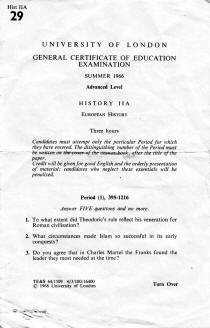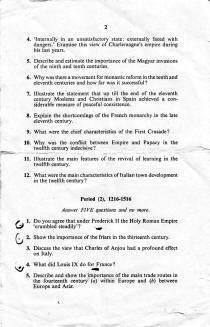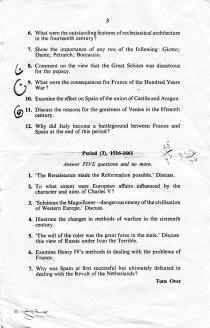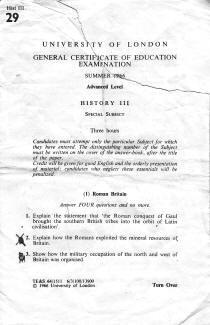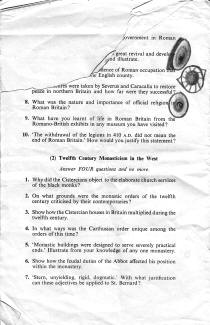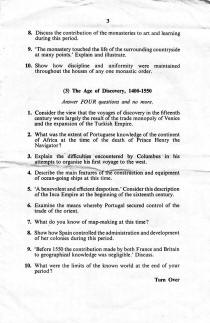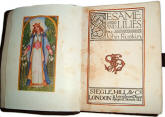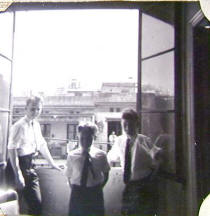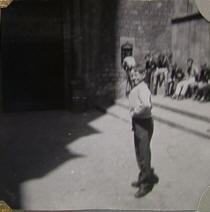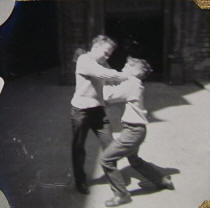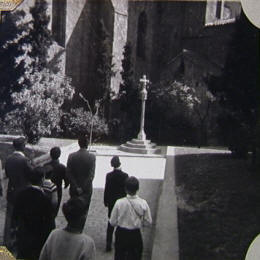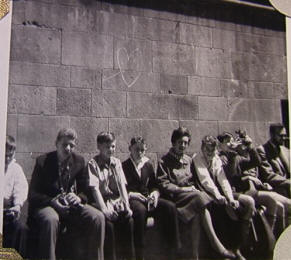|
John Walker (JRGS 1958-65) recalls positive & negative aspects of school life... |
|
|
I have recently come across John Byford
(JRGS 1959-66), who directed me towards the site, which I found
totally absorbing. Thanks for all your efforts in getting it up and
running.
Life at JRGS, Upper Shirley Road A Positive Experience in Sixth Form
On the up side, I really appreciated the infectious enthusiasm of
some of the 'masters' I experienced in the lower school, notably Mr.
"Fred" Field, whose English and Drama lessons were a captivating
delight. (I appeared in some of his junior dramatic society
productions.) I enjoyed history very much, with teachers such as Mr.
"Jack" Rhodes (who I believe got his nickname as an homage
to the great Ray Charles number Hit The Road, Jack). Life after JR Grammar School
As I've said, I quickly lost contact with other Ruskinites, and
almost my only connection with Croydon for some decades now has been my
regular pilgrimages to Selhurst Park, where I continue to have a
long-term season ticket for Crystal Palace. (I sold programmes there for
a number of years, while at Ruskin.) I have managed to pass the Palace
virus on to my two sons, who join me regularly, despite having no other
connection whatsoever with the Croydon area (glory-hunters!).
|
|
Richard Thomas (JRGS 1957-64) discovers a vintage image from December 1964... |
|
Ian’s comprehensive background to the
School Dance - The Christmas Cromagnon Convention - was very
interesting; I had not heard all of that before. The only small
correction I would offer was that the dinosaur was a Stegosaurus - the
type with two close but parallel rows of plate-like features extending
down its spine. (It was otherwise similar in body shape to a
Brontosaurus.)
Richard "Tom" Thomas, Shrewsbury, Shropshire. March 2009 Email Cliff Preddy (JRGS 1963-65) adds: The band that played at the Christmas Cromagnon Convention was The Desperados. The John Ruskin upper sixth-former who played bass guitar for them was Alan Shove. Alan and I have remained close friends since meeting at John Newnham School and moving on to John Ruskin together for sixth-form studies. Alan Shove (JRGS 1963-65) confides: Yes it was me! As the least talented of the group I was relegated to bass guitar and was never allowed to sing (thankfully). I am still in touch with two other group members who continue to play guitar but many miles apart. Cliff Preddy was a follower only; his talents lay in other directions. Bob Hawkins (JRGS 1958-64) adds: Whilst on the subject of incidents in that Division Room "A," does anyone remember an incident with the door handle, a recording device and a certain Welsh Latin master? The phrase "Oh my hat!" sticks in my mind to this day.
Richard Thomas comes clean:
Having, at that time, long since dropped out of Latin, I was not present
at the incident, but I recall being told about another event involving
Mr. "Rhino" Rees.
Paul Graham (JRGS 1959-66) adds: Thanks for these great memories,
especially to Ian Davies for reminding me about Steg and the CCC,
as well as paving the way for a new era of annual school dances (as they
used to be quaintly called).
Maurice Whitfield (JRGS 1959-66)
adds: Richard Thomas, Cliff Preddy and Alan Shove have
excellent memories. The band definitely was called The Desperados
and I thought included me, perhaps on drums or guitar, and also
Andrew Jackson on guitar, but memories can deceive. I don't recall
the other members. (I still play bass guitar to this day with my band
Big Road.) Was there a disco as
well? Cliff Preddy reflects: I rather doubt that many of us had “had a few”. My recollection is that Mr. Lowe had exceptionally strong views on the subject of alcohol, and probably wouldn’t have allowed alcohol or anybody who had been near alcohol that evening onto the premises.
Richard Thomas ends the
correspondence: Further to Maurice’s comments I confirm
that at least Brian Lee and I stood inside the body of the Steg and
literally “walked” it for part, if not all of the way to the “Shirley Schools”. Regarding the “walking” of the Steg and other
memories which have been emailed, on
page 14 of the
1965 School Magazine, there is a "Prefectorial" article which, I
assume, Ian Davies wrote. It includes the words "Many have slept
in Div Room A under the auspices of the title, Prefect, although since
the departure of Tom and Woxig it has been easier to hear the radio." |
|
Maurice Whitfield (JRGS 1959-66) unearths History A-Level papers from 1966... |
||||||
|
These GCE A-Level examination papers are
seven and nine pages long, respectively. The syllabus we pursued then with Mr.
Alan "Eggo" Murray, the History Teacher, is all contained
within the first three pages of each, as best I remember. Click on any
thumbnail to view a large version and
here to view a PDF file.
All material ©1966 University of London, All rights reserved. Reproduced under Fair-Use Doctrine for research. Maurice Whitfield, Woodside Green, London SE25 Email John Byford (JRGS1959-66) adds: Thanks for a sight of these. Some of the questions would challenge even the smartest kids on the block today; back in 1966 Mr. Murray's tuition would have guaranteed that Ruskin boys would have sailed through with flying colours. While Mr. Murray taught us British and European History there was no teacher to teach us Roman Britain (or did we have a novice Latin teacher?); it was very much self- taught.. Mr. Murray told me that my Grade "B" would have been an "A" with a proper teacher for Roman Britain. C'est la vie. |
|
Richard Thomas (JRGS 1957-64) unearths a copy of the 1923 school magazine... |
|
And
on Friday, 19th December, 2008, Martin Preuveneers (JRGS
1958-65), Ian Macdonald (JRGS 1958-65) and myself met in
London at the Chesterfield Hotel, Mayfair. This was the first time we
had met in over 40 years. At some time during a good lunch and the following few hours of
reminiscing, the idea of the September 2009
Ruskin Reunion was
born. Richard "Tom" Thomas, Shrewsbury, Shropshire. February 2009 Email
Paul Graham (JRGS 1959-66)
adds: The 1923 magazine is a time
capsule from another era. Written only four years after the school’s
foundation, much of it now seems as remote to us as Tom Brown’s School
Days. Mr. Field, the first head teacher, seeks parents’ support
in his aim that “boys should leave this school able to speak their own
language in a refined manner … and with an accent free of the
cockneyisms which are so prevalent in the neighbourhood”. The number of
pupils is up to 400. |
|
Alan Maynell (JRGS 1957-62) follows the provenance of a book by John Ruskin... |
|
From what I have been able to
glean from the Internet, it is an early version since it only contains
two chapters. Paul Graham (JRGS 1959-66) adds: I used Google.co.uk and found this entry and this one. Interested Alumni can read the whole of Sesame and Lilies here. The book was first published in 1964/65. There is also an entry about John Ruskin on Wikipedia. If Alan’s book only contains two chapters, I would have said it’s more likely to be a later edition, a sort of sampler. The German-language website URL above says that the Siegle, Hill & Co edition was published in 1910. John Byford (JRGS 1959-66 - formerly with the British Library): I am minded to agree with Paul that the item is "a sort of sampler". The British Library has some items from "The Queens Library of Literary Treasures" series, including Alan's Sesame and Lilies, all bar one published in 1910, suggesting that it was a short lived and unprofitable venture on the part of the publisher. I have located copies for sale [for $150 and $192, respectively]. Alan Maynell, Sierra de Bedar, Almeria Province, Spain, February 2009 Email |
|
Norman Day (JRGS 1960-66) recalls a school trip in 1961 to Spain... |
|
I took these pictures during a school trip to Spain in 1961, when I was 12. They are not very good quality, although they're evocative for me at least! It was an amazing trip in many ways – mainly I think due to the "liberal" tendencies of that excellent master, Mr. "Jim" Crowe, and another whose name I don’t recall but who, I believe, also came from the English department. We were given what now seems a surprising amount of freedom. For example, a blind eye seems to have been turned to all the wine we openly consumed! However, no one actually got drunk and abused that privilege that I remember. Click on any thumbnail to view a larger version.
From the evidence of the photos
there was also a female chaperone (possibly one of the master’s
wives?) but I don’t really remember her - perhaps she was
actually a guide? I certainly remember a woman taking us round
the cathedral. Anyway, no one stopped Dixon, Stokes
and I sneaking out of the hotel in the evening to drink Muscatel
in a cafe on occasion – though we were a bit wary of Franco’s
heavily armed police! As far I know, we were not breaking any
contemporary Spanish law (nor indeed were the ones looking after
us) with our consumption of wine. Also we bought the wine
ourselves quite openly, so there couldn’t have been that much.
Derek Charlwood (JRGS 1958-64) adds: In the photo with
the rather elegant lady above right, I believe that the
boy sitting second from left as we look, leaning forward,
wearing a blazer, is Derek Chase. However he would have
been a year or two older than Norman Day, joining JRGS at the
same time as me, in 1958. Norman Day, Markyate, near St. Albans, Hertfordshire. January 2009 Email. |
|
Archived News/Events Pages have been moved here. |
|
The content of this web site is provided for educational purposes only, and is subject to change without notice. The JRGS Alumni Society makes no representation about the accuracy, reliability, completeness or timeliness of the content of this web site, nor the results to be obtained from using any part of such content. |
Please send any messages and memorabilia to
webmaster
©2026 JRGS Alumni Society. All
Rights Reserved. Last revised:
07.12.25

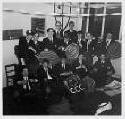
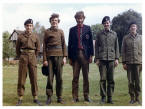
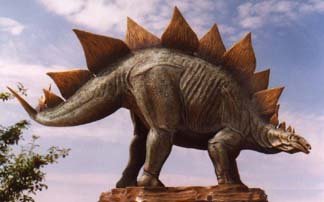 The
wire and papier mache dinosaur was modeled on a Stegosaurus. and was a
large construction, at least seven feet high and visible from the playground
in the Art Room windows. It was just like this one shown left. I think
it was constructed in parts so it would go through the Art Room door. It
required a real team effort to make and I remember myself and Julian
Smalley being involved, among others.
The
wire and papier mache dinosaur was modeled on a Stegosaurus. and was a
large construction, at least seven feet high and visible from the playground
in the Art Room windows. It was just like this one shown left. I think
it was constructed in parts so it would go through the Art Room door. It
required a real team effort to make and I remember myself and Julian
Smalley being involved, among others.